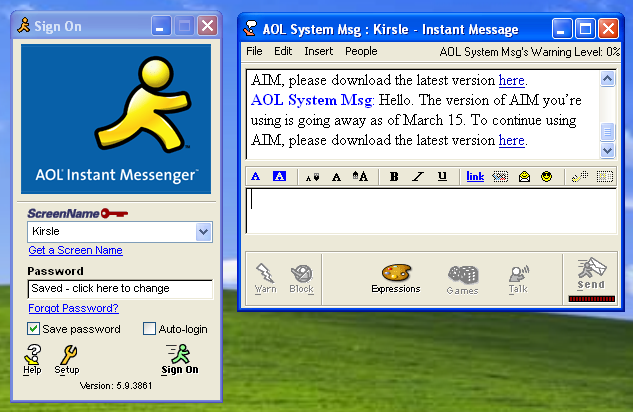You’ve got mail. For many people, AOL Instant Messenger was their first experience with live chat. It wasn’t really the first of course, as real-time chat has been around pretty much since the first time that two people shared a computer. It wasn’t until the 1990s, however, that it integrated itself into our lives. AOL Instant Messenger launched in May, 1997 and the world hasn’t been the same since.
AIM begat Google Chat, and Microsoft Messenger, both of which died early deaths while AIM is surprisingly still out there. Most folks moved away from messaging toward texting in the 2000s, but then things got even more confusing.
Twitter could be seen as a form of instant messaging, one where everyone reads what you’re saying. So could Instagram and Snapchat. And then there’s Facebook Messenger, which seems to be the most durable of the IM programs at the moment, somehow doing much better than Google’s multiple attempts to break into the space. Skype, once an up-and-comer, seems to have faded even though it’s installed by default on pretty much every Windows PC.
And then of course there’s WhatsApp, which seems to be the new breakout performer in the IM wars. Realistically it doesn’t have a lot of function that you can’t find somewhere else but the kids think it’s cool.
Add to all that mess, your office probably uses some sort of instant messaging. I know mine does. And chances are, it’s not completely compatible with anything else.
Instant messaging, once the exclusive province of the desktop PC, has gone mobile along with the rest of the world, but the problem is that each service has its own app and that means a lot of bopping back and forth while you’re trying to use your phone for something else. There are a few “aggregator” apps out there like Trillian, too. Trillian has been trying to make sense of the IM landscape literally for over a decade, combining instant messaging services into one neat bundle, but it’s perpetually behind. If you want to IM like it’s 1999, Trillian’s the one for you.
It’s clear that we have a need for instant messaging of some sort, but between texting and all the independent messaging apps, it’s totally out of control. It’s amazing to think that after 20 years of mass-market messaging, some how the “aging” of IM has simply left us with a “mess.” (See what I did there?) How could this be?
The problem is in our fickle nature. If you look at Skype, Facebook, WhatsApp, Google Hangouts (and its successors,) WhatsApp, and all the iOS stuff, you’ll find that the feature sets are pretty common. You can call anywhere for free, text message, send pictures and links. The only difference is “what’s cool.” People born after 2000 have an aversion to Facebook, which is largely populated by their parents and grandparents, while older folks have no interest in learning WhatsApp or Snapchat. If we could all come together for our own best interest, we’d be a lot better off.
The one thing that we all seem to agree on is the lowest common denominator, texting. Texting has improved to the point where it’s a capable form of IM, but still lacks some of the features AOL had in 1997. But at least everyone has it and if you know someone’s phone number you can connect to them. Is that really the best we can do?
I’m not saying the world isn’t full of all sorts of much more important problems, but hey, when we all get a spare moment, can we put some brainpower into fixing IM? It’s really worth it and we’ll all be glad we did.





